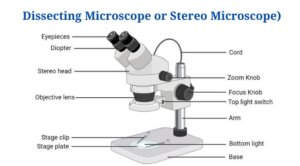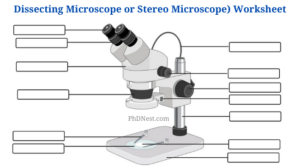Dissecting Microscope (Stereo Microscope)
Dissecting Microscope or Stereoscopic microscopes are another name for these. Dissection microscope is a digital optical microscope having low magnification power (5x-250x) which uses light reflected from the specimen’s surface instead of light reflected from the specimen itself. Its principal function is to dissect specimens as well as observe as well as analyse the dissected samples qualitatively.
Cherudin d’Orleans invented it in 1677 by creating a tiny microscope with two distinct eyepieces as well as objective lenses.
Later in 1852, an inventor named Charles Wheatstone released a paper titled ‘On Some Remarkable, as well as Hitherto Unobserved, Phenomena of Binocular Vision’ which described the basis of stereoscopic viewing. It was later advanced by John Leornld Riddell, who published it as ‘On Binocular Microscope’ in the Journal of Microscopical Science.Horatio S.
Greenough, an American biologist, designed the stereo microscope, which has two independent yet similar optical channels, as well as created it with the Carl Zeiss Company, which still manufactures the Dissecting Microscope.
Dissecting Microscope (Stereo microscope) Principle
- The dissecting Microscope’s working principle is based on the two types of light routes used by the microscope’s objectives as well as eyepiece. Each light path delivers a unique perspective. Dissecting microscopes have a top light which is used for dissecting as well as a bottom light for viewing the photos.
- The design of two eyepieces (binocular stereoscope) allows for this lighting, each exhibiting a different sort of light pathway as well as offering a viewing comfort area.
- The photos are displayed live on a computer monitor screen in 3-dimensional visuals because it is a digital microscope. Dissecting microscope also allow for very close observation of minute specimens like insects, with images which are typically larger than the sample size, a phenomenon referred to macro-photography. The image is recorded, as well as the topography (surface) of complicated samples is examined in 3D.
- The dissecting microscope has two magnification systems: fixed (primary) magnification, which uses two objective lenses to offer a degree of magnification, as well as zoom (pancratic) magnification, which uses auxiliary objectives to provide continuous magnification at various ranges, Based on some factors. The eyepiece lenses can be changed to achieve a difference in magnification between zoom as well as fixed magnification.
- Between fixed as well as zoom magnification is the Galilean optical system, which features fixed-focus lenses which confer fixed magnification for various sets of magnification, like two sets of magnifications offer four magnifications, three sets offer six magnifications, as well as so on.
Dissecting Microscope Parts (Stereo microscope)
Figure: Labeled Dissecting microscope (Stereo or stereoscopic microscope)
- LED illuminators– Some dissecting microscopes contain an integrated LED illuminator as a light source.
- Eyepieces– Dissecting microscopes have two eyepieces, each with its own magnification power, which focus various pathways of light into as well as out of the specimen. The usage of supplementary eyepieces can be utilised to boost magnification.
- Objective lenses– Dissecting microscopes have various magnifications for focusing the image on the digital camera, as well as the addition of auxiliary objectives is utilised to boost magnification.
- Stage– This is the apparatus which will be used to place the specimen. Because dissecting microscope are big, such dissecting microscope can accommodate huge specimen apparatus.
- Optical system– This is the system which provides fixed-focus lensing as well as is found between fixed as well as zoom magnification.
- Digital camera—many dissecting microscopes have a digital camera which is temporarily fixed for capturing images as well as recording the results of the photos. Depending on the kind of digital camera installed, it can capture 2D as well as 3D photos.
Dissecting microscopes (Stereo microscope) come in a variety of shapes as well as sizes. They are:
- Stereo Zoom Dissecting Microscope– A stereo zoom these dissecting microscope is a trinocular or binocular these dissecting microscope with a zooming range of 6.7x to 45x. such dissecting microscope can be connected to a digital camera which captures pictures of the images being viewed. Dissecting microscopes have a 360-degree rotation as well as a dual-LED illumination. Adding supplementary objectives or switching eyepieces can modify the magnification.
- High-end dissecting microscopes, like the Digital Tablet Dissection Microscope. Dissecting microscopes have a 6.7x-45x continuous magnification touch screen LCD tablet camera. Dissecting microscopes have auxiliary eyepieces with different magnification ranges which may be adjusted. Auxiliary lenses can be used to change the magnification of the objectives. Dissecting microscopes have a 5.0-megapixel digital camera which can be used to capture photographs as well as record videos directly onto the tablet or via a USB cable. Both the top as well as bottom of the microscope contain built-in LED illuminators which operate independently.
- Stereo zoom boom stand microscopes—These microscopes feature the largest base as well as stage for viewing big samples. Such microscopes offer LED lighting or dual-pipe lighting as an option. Dissecting microscopes have a zoom range of 6x-45x which can be increased by using auxiliary lenses or eyepieces.
- Stereo Zoom Dissecting Microscope– It is a small stereo zoom these dissecting microscope which has a zooming range of 10x-30x as well as produces sharp parfocalled images. Because dissecting microscope contain a rotating head, the eyepiece can be angled away from or toward the specimen. Dissecting microscopes have a 10 watt halogen lamp as well as a 5 watt fluorescent light.
- Dual Power Dissecting Microscope– It features a 10x as well as 30x dual-powered dissecting microscope with 360° rotation for focusing as well as viewing. Dissecting microscopes have a parfocalled, parcentered, as well as achromatic dual objective pair. The visual magnification may be changed by rotating the lenses. This also has a high-intensity LED light ring which illuminates the entire surface. This microscope can be hoisted head high for viewing larger specimens with a flexible stand.
- 6. Single Power Stereo Dissection Microscope– these Dissecting microscopes have very low magnification power ranging from 10x-40x with slanted eyepieces at 45°C as well as have extremely low magnification power ranging from 10x-40x. These microscopes also offer 50mm to 70mm diopter settings.
- Single Magnification Handheld Pocket Microscope– it is a lightless, single-powered handheld dissecting microscope with two magnification capabilities. It is made in Japan as well as features high optical quality glass with a lot of simplicity of use. It is also portable due to its small size.
Types of Dissecting Microscope or Stereo Microscope
1. Stereo Zoom Dissecting Microscope:
It is a trinocular or binocular Stereo Microscope.
It has a zooming range of 6.7x-45x.
It also contains digital camera which captures photos of the viewing images.
It contains a rotatable (360 degree) dual-LED illuminator.
The total magnification power can be changed with the addition of an auxiliary objective.
2. Stereo zoom boom stand microscopes:
It comes with a larger stage and base.
It contains optional dual-pipe lighting.
It has a magnification power of 6x-45x, which can be changed with the additions of an auxiliary lens.
3. Digital Tablet Dissection Microscope:
It is a high-end Stereo Microscopes.
It contains a touch screen LCD tablet and camera.
The camera comes with a magnification power of 6.7x-45x.
It also contains an auxiliary lens to increase or decrease the magnification power.
It contains a 5.0-megapixel digital camera to capture the image.
It also contains inbuild LED lights both at the top and bottom of the microscope.
4. Dual Power Dissecting Microscope:
It has a magnification power of 10x and 30x.
It has 360° rotation ability.
It contains dual objective pair, parfocalled, parcentered, and achromatic.
It contains a high LED intensity light ring.
5. Single Power Stereo Dissection Microscope:
It contains a magnification power of 10x-40x.
It also contains diopter adjustments of 50mm to 70mm.
6. Single Magnification Handheld Pocket Microscope:
It is a single powered handheld Stereo Microscope.
It has two magnification powers without any light.
Read Also:
Bright Field Microscope: Definition, Parts, Diagram, Principle, Application
Parts of Microscope, Microscope Labeled Diagram and Functions
Dissecting Microscope Applications (Stereo microscope)
This microscope is employed in a variety of fields, like manufacturing, medical, quality control, inspection, as well as biomedical investigations like entomological studies of insects, as are many microscopes, as well as some of its functions include:
- Investigating solid sample topography
- for microsurgical procedures 2. for dissection
- For the production of watches as well as circuit boards, as well as their examination
- Used to check for fractures (fractography)
- It’s a forensic engineering tool.
Advantages
- It is a very important microscopic techniques because it can be utilised in a wide range of disciplines.
- The image can be visualised with considerable magnification disparities thanks to the utilisation of two light routes.
- The use of a digital camera allows the image to be recorded as well as viewed.
- It is lightweight as well as simple to operate.
- Such microscopes are designed to look at full specimens instead of parts.
Disadvantages
- The Galilean Optical Systems, which are an important component of the microscope, are relatively costly.
- Microscopes are generally expensive to buy.
- These microscopes don’t have a good magnification power, so These microscopes cannot see images at high magnifications (more than 100x), so dissecting microscope cannot be utilized to look at tissue structures or other structures.
Dissecting microscope (Stereo microscope) Worksheet
Dissecting microscope (Stereo microscope) Citations
- https://www.merriam-webster.com/dictionary/dissecting%20microscope
- Image created using biorender.com
- https://www.britannica.com/technology/microscope/Stereoscopic-microscopes
- https://prezi.com/piodcrdu3r08/stereo-dissecting-microscope/
- https://www.microscopeworld.com/t-dissecting_microscopes.aspx
- https://www.microscope.com/stereo-microscopes/
- https://quizlet.com/218886987/chapter-25-digital-imaging-flash-cards/
- https://archive.org/details/philtrans09004566
- http://www.agarscientific.net/microscope-configurations-a-brief-history-of-the-compound-inverted-and-stereo-microscopes/
- https://sciencing.com/function-microscope-6575328.html
- https://classroom.synonym.com/parts-dissecting-microscope-2577.html
- http://www.microscope-depot.com/p1.asp?pn=s-01522
Related Posts
- Phylum Porifera: Classification, Characteristics, Examples
- Dissecting Microscope (Stereo Microscope) Definition, Principle, Uses, Parts
- Epithelial Tissue Vs Connective Tissue: Definition, 16+ Differences, Examples
- 29+ Differences Between Arteries and Veins
- 31+ Differences Between DNA and RNA (DNA vs RNA)
- Eukaryotic Cells: Definition, Parts, Structure, Examples
- Centrifugal Force: Definition, Principle, Formula, Examples
- Asexual Vs Sexual Reproduction: Overview, 18+ Differences, Examples
- Glandular Epithelium: Location, Structure, Functions, Examples
- 25+ Differences between Invertebrates and Vertebrates
- Lineweaver–Burk Plot
- Cilia and Flagella: Definition, Structure, Functions and Diagram
- P-value: Definition, Formula, Table and Calculation
- Nucleosome Model of Chromosome
- Northern Blot: Overview, Principle, Procedure and Results


















